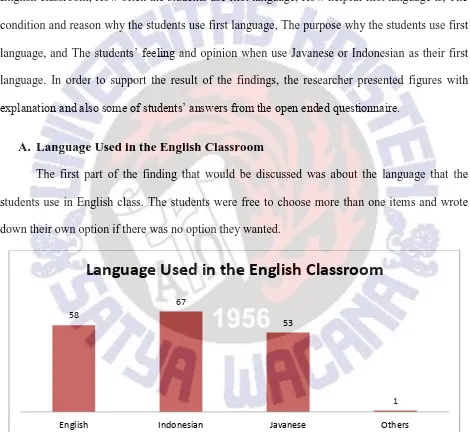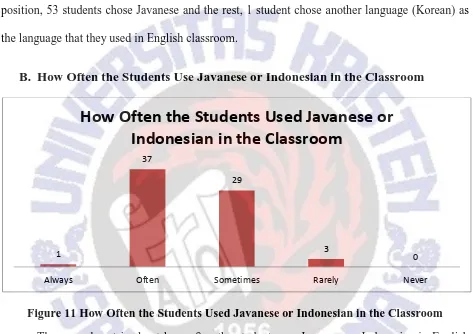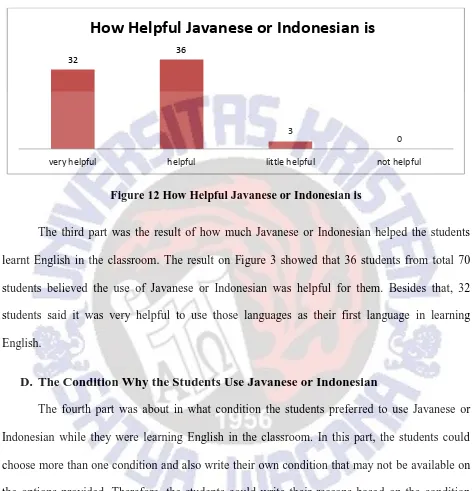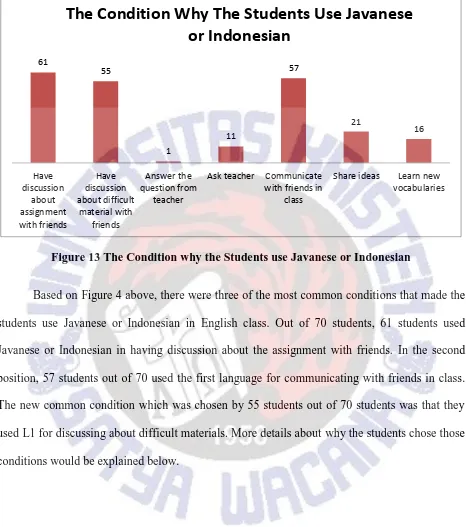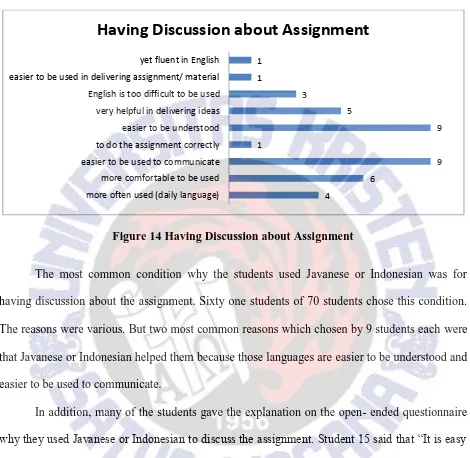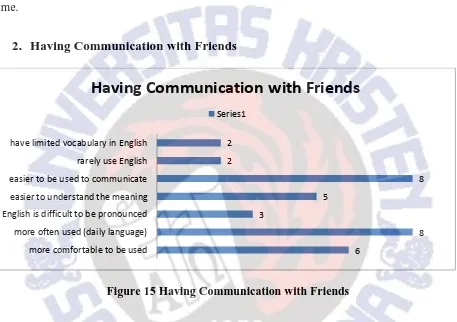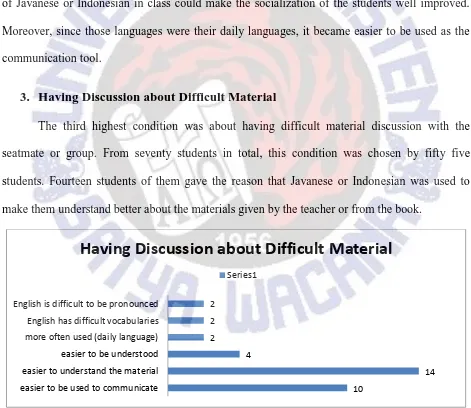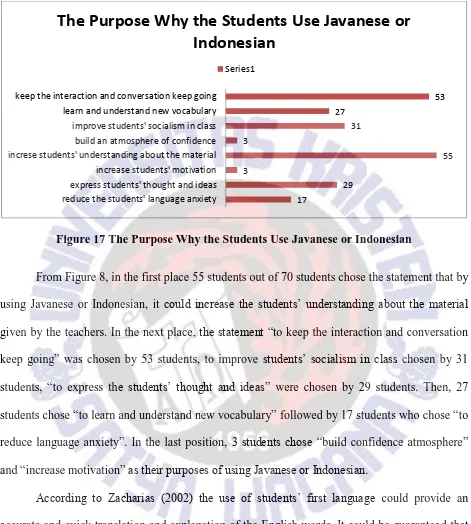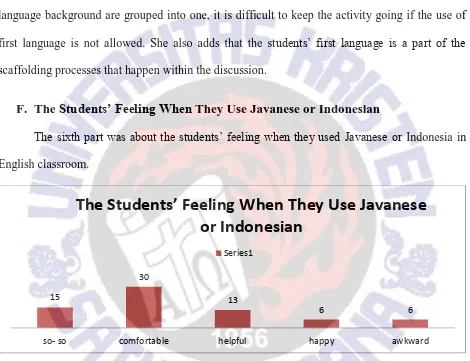i
STUDENTS’
PERCEPTION ON THE USE OF L1
IN A VOCATIONAL HIGH SCHOOL
THESIS
Submitted in Partial Fulfillment of the Requirements for the Degree of
Sarjana Pendidikan
Belinda Gita Puspita 112012027
ENGLISH LANGUAGE EDUCATION PROGRAM
FACULTY OF LANGUAGE AND ARTS
UNIVERSITAS KRISTEN SATYA WACANA
SALATIGA
vi
COPYRIGHT STATEMENT
This thesis contains no such material as has been submitted for examination in any course or accepted for the fulfillment of any degree or diploma in any university. To the best of my knowledge and my belief, this contains no material previously published or written by any other person except where due reference is made in the text.
Copyright @2016. Belinda Gita Puspita and Anne I. Timotius, M.Ed
vii
TABLE OF CONTENTS
Contents
Cover Page ... i
Pernyataan Tidak Plagiat ... Error! Bookmark not defined. Pernyataan Persetujuan Akses………iii
The Problem on Curriculum 2013 ... 4
Positive Aspects on the Use of First Language ... 5
Negative Aspects on the Use of First Language ... 7
Previous Study... 7
A. Language Used in the English Classroom ... 11
B. How Often the Students Use Javanese or Indonesian in the Classroom... 12
C. How Helpful Javanese or Indonesian is ... 13
D. The Condition Why the Students Use Javanese or Indonesian... 13
1. Having Discussion about Assignment... 15
2. Having Communication with Friends ... 16
3. Having Discussion about Difficult Material ... 17
E. The Purpose Why the Students Use Javanese or Indonesian ... 18
F. The Students’ Feeling When They Use Javanese or Indonesian ... 20
Conclusion ... 21
References ... 24
Acknowlegment ... 26
viii
TABLE OF FIGURES
Figure 1. Language Used in the English Classroom………11
Figure 2. How Often the Students Used Javanese or Indonesian in the Classroom………12
Figure 3. How Helpful Javanese or Indonesian is………...13
Figure 4. The Condition why the Students use Javanese or Indonesian………..14
Figure 5. Having Discussion about Assignment………..15
Figure 6. Having Communication with Friends………..16
Figure 7. Having Discussion about Difficult Material……….17
Figure 8. The Purpose Why the Students Use Javanese or Indonesian………19
1
Students Perception on the Use of L1 in a Vocational High School
Belinda Gita PuspitaABSTRACT
The use of L1 in an English classroom has always been debated until now. On one hand, L1 gives benefits that make English easier to be learnt. On the other hand, the use of L1 gives disadvantages that cause error in learning English. However, it is still questionable whether the beginners need L1 to support them to learn English. Although many researches did not support the use of L1 in L2 classroom, the reasons and purposes why the students use Javanese or Indonesian in an English classroom are very important to be known. So, this study was done to find out the students’ perceptions on the use of L1 in the English learning process. The participants were 70 students in the first grade of Vocational High School 1 Salatiga. The open-ended questionnaire was distributed to the students to get the data. The study shows that most of the students had positive responses toward the use of first language in English learning process in classroom.
Keywords: first language, purposes why use L1, students’ perception
INTRODUCTION
2
School, Senior High School, and Vocational High School students either in public or private schools have to follow.
In Vocational High Schools, especially in SMKN 1 Salatiga, provides many kinds of programs, for instance cloth designer major, make-up major, cooking major, office administration major, marketing major and also accountancy major. Unlike regular high schools, the students in vocational schools should master a particular subject that will help them to prepare and compete in their future occupational work. As stated by Budiantri, Nitiasih, and Budasi (2013), English subject at a Vocational High School is aiming to train the students to be able to communicate using intermediate English level. It means the students at a Vocational High School have to work hard in learning English to understand and use English.
In addition, since Mappiasse and Sihes (2014) stated that the status of English in Indonesia is as a foreign language or in other words it is not Indonesian’s first language, the students who learn this language have to work hard to understand this language. As the researcher found in SMKN 1 Salatiga, the teachers delivered the English materials using both students’ first language and English. It will make the students learn English easier by using the
help of their first language. Unfortunately, some teachers and students have different opinions about the learning strategy using students’ first language. Furthermore, as proven by Sharma (2006) the question of whether English teachers should use the students’ first language in
English classroom has always been debated (p. 80). It can be said that people have their own perception towards the use of students’ first language as a learning strategy.
3
be maximized to make them have better proficiency. In other words, the students will be more fluent in English since they are taught using English which makes them more familiar with it. On the other hand, the students who do not have a good English proficiency may feel an extra burden in class since they have to both understand the English used as the medium of instruction and English lesson itself. Consequently, these students may feel that English is a difficult subject to be learnt.
The purpose of this study is to investigate the perception of tenth grader students in vocational high school toward the use of first language in English class. Specifically, this study addresses the following research question: “What are the ten grader students’ perceptions towards the use of their first language in English class?” By investigating that, the researcher wish to find out the language used by the students in an English classroom, how often the students use their first language, how helpful the first language is, the condition and the reason why the students use their first language, the purpose why the students use first language, and the students’ feeling and opinion when use Javanese or Indonesian as their fist language.
It is hoped that the finding of the study will help the teacher know about the students’ perception on the use of their first language in English classroom. Therefore, the findings may help the teachers in choosing the learning strategy whether they will use students’ first language, English or both students’ first language and English in English classroom. It can also be useful
4
LITERATURE REVIEW
The Problem on Curriculum 2013
In Indonesia, as stated by Sahirrudin (2013), English is the first foreign language obliged to be taught at junior high school and also senior high school as determined by the Indonesia government policy. Afterwards, English is taught as a foreign language across the curriculum in the private and public schools. It became a compulsory subject which is taught in Junior High Schools, Senior High Schools, and also Vocational Schools. According to Sahirrudin (2013), the time allotted for English subject at schools is reduced regarding on the new curriculum which is called curriculum 2013. On this new curriculum that is now used in schools, English is only taught 2 hours a week. It certainly brings several consequences for language teaching and learning process in Indonesia. Not only teachers but students have to work harder to master all English materials. By knowing that fact, it can make students have preference to use easier ways to learn English. One of them is by using students’ first language during the learning process. It
is proven by Rodrigues and Oxbrow (2008) that found out most of the students feel the use of L1 in the English classroom actually help them improve their L2.
The Purpose of why the Students Use First Language in Class
5
Another reason was mentioned by Morahan (2002) who believed that first language vocabulary allows learners to use language which they may not yet possess in second language in order to process ideas and reach higher levels of understanding. Furthermore, Nation (2001) claims that when the first language is used to translate new vocabulary, the students will expand their lexical input faster. In other words by using first language, it will be beneficial for the students to learn and understand English vocabularies better.
The use of first language can also improve students’ socialism in class. Balosa (2007)
suggests that the use of first language can build an atmosphere of confidence and friendship in the classroom. Besides, the students’ self- image and motivation will improve when the students
are no longer frustated by not understanding classroom instruction presented in the target language only.
The use of first language in the discussion can keep the interaction and conversation going. Nation (2001) states if first language is used in class discussions, the students will involve actively and understand English vocabulary better. Moreover, Cook (2008) believes when the students who have the same language background are grouped into one, it is difficult to keep the activity going if the use of first language is not allowed. She also adds that the students’ first
language is a part of the scaffolding processes that happen within the discussion.
Positive Aspects on the Use of First Language
6
students’ linguistic schemata that can build their understanding about a new language and be
used in explaining things. In other words, the first language is the students’ resource to get the meaning of a new language that will use the students’ first language to process the information.
In addition, the first language can be used as a good learning strategy. The use of first language in the form of translation technique is a preferred learning strategy that mostly used for learners (Atkinson, 1987). It means new concepts or difficult words of English can be translated through first language. Moreover, by using students’ first language, it will help the students understand the meaning of the materials rather than only using English. Third, the first language can be used as a tool to think. In other words, L1 use can help the students to express their thought so that they can know what is being learnt at that moment. Auerbach (1993) and Dajani (2002) found that the use of the students’ first language provided many positive effects, for
instance teaching new vocabulary word and discussing difficult English material. In summary, L1 took an important role in learning when the students do not clearly understand about new vocabulary words and new concepts.
7 Negative Aspects on the Use of First Language
On the other hand, some researchers stated that the use of first language will obstruct students in learning English. Pujiastuti (2013) pointed out that if the students still use their first language, they will get the limitation of using English in learning process. Moreover, the students may feel distressed during and after learning English. It will not help them to be better in learning English. The students will be more fluent in English if they use English more often, especially in learning process.
Januliene (2008) stated that the more students use their first language the more they will feel embarrassed. It can be said as a source of embarrassment since other students may think that students who speak using their first language in English class may have difficulties in speaking English. Moreover, it will be worse for the students if they have less confidence they had, because it can lead them to have no enthusiasm in learning English. Besides that, Pujiastuti (2013) believed that the use of students’ first language should be decreased in learning English. The students will develop their proficiency better if they use English in learning process.
Previous Study
In addition, some previous studies also discuss about the use of first language that can give benefits to the students in learning English as their foreign language. The study by Huang (2006) investigated students’ attitudes towards their first language in a writing class in Chaoyang
University in Taiwan. Huang (2006) found that many students thought the English teachers have to use students’ first language to explain grammar in order to have better understanding. They
8
The students who are the participants on this study felt that if the teachers used their first language more often during the class, their chances to listen and use English would not be as much as if the teachers use English.
The other previous study about the use of first language in English as a foreign language was done by Sharma. Sharma (2006) conducted a study on the use of the Nepali language in Nepal’s secondary schools. The researcher looked at the frequency of the first language use and
the attitudes of teachers and students towards the use of the first language. Sharma found teachers used Nepali to explain new concepts and vocabulary, give instructions of the activities, and explain grammar rules. While the students used Nepali for various reasons, especially to explain new vocabulary and grammar rules. One percent of the total number of students hoped that the teachers would use Nepali a lot in class.
From those two different views of the use of first language (opposing and supporting), it can be concluded that students’ perceptions can be different in other contexts. In addition, there
is difference in this study and the previous studies. The previous study took place in a regular school. This study took place in a Vocational High School which has different programs and subject. As a result, it is interesting to find out how the students’ first language can be used to
help the students have a better understanding in learning English in vocational school.
THE STUDY
Context of the Study
9
the data easier since the researcher has known the teachers and the students that would become the participants. The second reason was that when the researcher became a student teacher in SMKN 1 Salatiga, the researcher found the students did not really understand the materials if it was delivered in English. Then, during the learning process, the English teachers of the school used both Indonesian and English in delivering the material. It makes most of the students accustomed to the use of their first language in learning process. Therefore, for that reason, it has made the researcher curious and wants to investigate finding the perceptions of the ten graders in that vocational school towards the use of L1 in the English classroom.
Participants
The setting of the study was the tenth grade students in the second semester of academic year 2015/2016. Ten grader students were chosen as participants since they were in the transition period from Junior High School and Senior High School. There were 70 students who participated from two classes. The range of the students’ age was between 15-16 years old.
Instrument of Data Collection
This research used a questionnaire as the instruments of the data collection. Indonesian was used in the questionnaire to make the participants fill the questionnaire easier. The questionnaires were distributed to all students in two classes. There were 70 questionnaires. The use of questionnaire was needed because I sought for as many opinions as possible. The questionnaire consisted of six questions related to the topic of study. The questionnaires were open- ended (Appendix 1), since “the participants are free to write their responses in questions given instead of being controlled by the choices design by the researcher” (Zacharias, 2011).
10
questionnaires which “allow the participants to voice their individual points of views”, (Zacharias, 2011) would trigger more varied answers.
Procedures of Data Collection
The researcher asked for a letter of permission from the Faculty of Language and Arts to get the permission from SMKN 1 Salatiga to collect the data. After that, the researcher went to SMKN 1 Salatiga to ask for a permission to do a research there. Then the researcher made an appointment for the time to collect the data. Then, the researcher distributed the questionnaire to the students after class, so the data collection would not disturb the learning process. Before the participants filled out the questionnaires, the researcher explained the purpose of the study and the questionnaires in order to avoid confusion among them.
Procedures of Data Analysis
11
FINDING AND DISCUSSIONS
In this section, the researcher would discuss and analyze the finding from the data as the answer from the research question, “For what purposes do the students use their first language in English class?” This section presented six parts of the data; The language used by the students in
English classroom, How often the students use first language, How helpful first language is, The condition and reason why the students use first language, The purpose why the students use first language, and The students’ feeling and opinion when use Javanese or Indonesian as their first language. In order to support the result of the findings, the researcher presented figures with explanation and also some of students’ answers from the open ended questionnaire.
A. Language Used in the English Classroom
The first part of the finding that would be discussed was about the language that the students use in English class. The students were free to choose more than one items and wrote down their own option if there was no option they wanted.
Figure 10 Language Used in the English Classroom 58
67
53
1
English Indonesian Javanese Others
12
Based on the findings of the questionnaire, Indonesian was in the highest position of language that the students’ used to communicate while they were in English class. Sixty seven students out of 70 students chose Indonesian as the main language that they used. The second position was English with the total of 58 students who chose that. Afterward, in the third position, 53 students chose Javanese and the rest, 1 student chose another language (Korean) as the language that they used in English classroom.
B. How Often the Students Use Javanese or Indonesian in the Classroom
Figure 11 How Often the Students Used Javanese or Indonesian in the Classroom
The second part is about how often the students use Javanese or Indonesian in English class. Based on the previous result, Indonesian and Javanese had high percentage of the language that the students used while they were having a lesson in English class. Figure 2 revealed that 37 students of total 70 students used Javanese or Indonesian often in English class. Other than that, 29 students sometimes used Javanese or Indonesian. This result showed that the percentage the use of Javanese or Indonesia using by the students was quite high.
1
37
29
3
0
Always Often Sometimes Rarely Never
13 C. How Helpful Javanese or Indonesian is
Figure 12 How Helpful Javanese or Indonesian is
The third part was the result of how much Javanese or Indonesian helped the students learnt English in the classroom. The result on Figure 3 showed that 36 students from total 70 students believed the use of Javanese or Indonesian was helpful for them. Besides that, 32 students said it was very helpful to use those languages as their first language in learning English.
D. The Condition Why the Students Use Javanese or Indonesian
The fourth part was about in what condition the students preferred to use Javanese or Indonesian while they were learning English in the classroom. In this part, the students could choose more than one condition and also write their own condition that may not be available on the options provided. Therefore, the students could write their reasons based on the condition given. It was an important point to know the reason why the students used their first language during the English class.
32
36
3
0
very helpful helpful little helpful not helpful
14
Figure 13 The Condition why the Students use Javanese or Indonesian
Based on Figure 4 above, there were three of the most common conditions that made the students use Javanese or Indonesian in English class. Out of 70 students, 61 students used Javanese or Indonesian in having discussion about the assignment with friends. In the second position, 57 students out of 70 used the first language for communicating with friends in class. The new common condition which was chosen by 55 students out of 70 students was that they used L1 for discussing about difficult materials. More details about why the students chose those conditions would be explained below.
15 1. Having Discussion about Assignment
Figure 14 Having Discussion about Assignment
The most common condition why the students used Javanese or Indonesian was for having discussion about the assignment. Sixty one students of 70 students chose this condition. The reasons were various. But two most common reasons which chosen by 9 students each were that Javanese or Indonesian helped them because those languages are easier to be understood and easier to be used to communicate.
In addition, many of the students gave the explanation on the open- ended questionnaire why they used Javanese or Indonesian to discuss the assignment. Student 15 said that “It is easy
to use to discuss with friend, so my friend and I will understand the assignment clearly” (translated). Student 51 also believed that “I will not misunderstand about the assignment given” (translated). Student 33 also said that “It is easier to use Indonesian, so my friend and I can do
the assignment better without wasting time” (translated). The students’ responses were similar to LaVan (2001) who said that the students’ use of their first language is a natural thing to do in the classroom. Similar ideas were also mentioned in Nation’s work (2003), that by using their first
4 easier to be used in delivering assignment/ material yet fluent in English
16
language, the students will get many advantages in having discussion. In other words, the use of Javanese or Indonesian in having discussion with seatmate or group mate was really helpful and gave benefit for the students. The assignment given would be easier and clearer because they know what they had to do. The time given would also be used maximally without wasting the time.
2. Having Communication with Friends
Figure 15 Having Communication with Friends
17
(translated). Student 45 also said that “I use Javanese and Indonesian to talk to my friends in class because those languages were my daily languages since I was a child” (translated). Student 62 also supported, “I can say many things using Indonesian” (translated).
In addition, the use of Javanese or Indonesian as first language could make them become closer to each other. According to Al-Nofaie (2010), students often use their first language to socialize with their friends. Leeming (2011) also added that the first language provides a social purpose in setting up and keeping up a positive way of working situation. In other words, the use of Javanese or Indonesian in class could make the socialization of the students well improved. Moreover, since those languages were their daily languages, it became easier to be used as the communication tool.
3. Having Discussion about Difficult Material
The third highest condition was about having difficult material discussion with the seatmate or group. From seventy students in total, this condition was chosen by fifty five students. Fourteen students of them gave the reason that Javanese or Indonesian was used to make them understand better about the materials given by the teacher or from the book.
18
In the figure above, 14 students out of 55 students who chose this reasons, told that by using Javanese or Indonesian, it was easier for them to understand the material given by the teachers. In the other words, the students could share and explain to each other using their first language to confirm what their teacher explained before. The second reason was that by using Javanese or Indonesian, the students would feel easy in having communication and discussing the material that might not be clearly enough explained by the teacher or from the book.
Students 18 said that “I have difficulties in understanding new English material because there was a lot of new vocabularies” (translated). Students 3 also said “Using Javanese or Indonesian help me to understand difficult materials” (translated). Student 46 added “By using
Javanese or Indonesian the communication becomes easier especially with the lack of English vocabularies”
Related to these findings, Dajani (2002) supported that teaching new vocabulary words and discussing difficult English are the benefit of using students’ first language. The students needed to use their first language to convey the meaning of words or even sentences in discussing materials with their seatmate or group mate. According to Cook (2001), the use of first language might be efficient for conveying meaning in order to help the learning process. Hassan and Jadallah (2011) added that the first language is useful to convey the meaning by giving the first language’s equivalence of the English word and sentence.
E. The Purpose Why the Students Use Javanese or Indonesian
19
Figure 17 The Purpose Why the Students Use Javanese or Indonesian
From Figure 8, in the first place 55 students out of 70 students chose the statement that by using Javanese or Indonesian, it could increase the students’ understanding about the material given by the teachers. In the next place, the statement “to keep the interaction and conversation keep going” was chosen by 53 students, to improve students’ socialism in class chosen by 31 students, “to express the students’ thought and ideas” were chosen by 29 students. Then, 27 students chose “to learn and understand new vocabulary” followed by 17 students who chose “to reduce language anxiety”. In the last position, 3 students chose “build confidence atmosphere” and “increase motivation” as their purposes of using Javanese or Indonesian.
According to Zacharias (2002) the use of students’ first language could provide an
accurate and quick translation and explanation of the English words. It could be guaranteed that the students would grasp the new vocabularies correctly which could make them understand the explanation or material well. Balosa (2007) also added by using the first language in the classroom, students can be more confident and get a good relationship with their friends. Moreover, Meyer (2008) stated that by the first language, it can reduce language anxiety that the
17
The Purpose Why the Students Use Javanese or
Indonesian
20
students feel. Besides. Nation (2001) stated that the students will expand their lexical input faster when they used the first language to translate new vocabularies. Nation (2001) also added if first language is used in class discussions, the students will involve actively and understand English vocabulary better. Moreover, Cook (2008) believes when the students who have the same language background are grouped into one, it is difficult to keep the activity going if the use of first language is not allowed. She also adds that the students’ first language is a part of the scaffolding processes that happen within the discussion.
F. The Students’ Feeling When They Use Javanese or Indonesian
The sixth part was about the students’ feeling when they used Javanese or Indonesia in
English classroom.
Figure 18 The Students’ Feeling When They Use Javanese or Indonesian
In Figure 9, the first highest feeling that they felt was about comfortable feeling. Thirty students from the total of 70 students felt comfortable in using Javanese or Indonesian in English classroom. The students said those languages were their daily languages which helped them understand in exchanging opinions during discussion (student 15), helped them express the ideas (student 37), helped them have communication and discussion with friends (student 33), helped them understand the material and helped them in communication (student 7).
15
30
13
6 6
so- so comfortable helpful happy awkward
The Students’ Feeling When They Use Javanese
or Indonesian
21
On the second highest position, 15 students out of 70 students did not feel any special with the use of Javanese or Indonesian in English classroom. Students 22 said that “I use Javanese or Indonesian in English classroom since I am in Elementary School” (translated). Students 61 also added “Javanese and Indonesian are my daily languages, I feel nothing special with that” (translated). Moreover, students 33 added “My teacher allows me to use Javanese or Indonesian in class” (translated).
The third highest position was about the feeling of being helpful. Student 27 said that “Sometimes I do not understand about English, but I understand better when it is explained in Javanese or Indonesian” (translated). Student 58 added “It is easier in learning new vocabularies” (translated). Furthermore, student 70 also added that “It is easier for me to explain about something in discussion” (translated).
The last position, with the same amount of students, 6 students, felt happy and awkward. The students felt happy because it is helpful (student 20), because it helps them communicate with friends (student 19), helps learn new vocabulary and avoid misunderstanding (students 29). On the contrary, there were students who felt awkward. The student 1 said “It is not appropriate to use Javanese or Indonesian in English class” (translated). Student 62 added “Actually, it is not good to use Indonesian because it is English class, but I am also happy because it is helpful” (translated).
CONCLUSION
The present study was designed to answer the research question: “What are the ten grader students’ perceptions towards the use of their first language in an English class?”. To find the
22
Based on the findings, it was asserted that the majority of the students in vocational high school use their first language, Indonesia, as the language that they used in learning process. Interestingly, English, which actually had to be used as the main language in English classroom, got the second position. Besides, more than half of the students often use Javanese or Indonesian when they were learning English in the class. They also added that Javanese or Indonesian was helpful for them. It was important to know the condition that made the students used those languages in English class and also the reason behind that condition. Three most common conditions came up from the questionnaire given to the students followed with the reasons. The three conditions were: “having discussion about the assignment”, “having communication”, and also “having discussion about difficult materials with the seatmate or group mate”. The students also mentioned the reason why they chose those conditions. It could not be ignored, as the students’ first language and also students’ daily language, Javanese or Indonesian was easier to
23
However, although there were some contra studies about the use of first language in the English classroom, this study showed that the first language was helpful for the tenth grader students in vocational high school. It was not only helpful in the learning process, but the purposes that the students mentioned were so reasonable to understand. English was not our first language which means it took time to learn and understand English well. Furthermore, the use of first language could make the learning process of English went very smoothly. As the result, the students’ first language could become a learning tool that would help the students learning English.
24
REFERENCES
Atkinson, D (1987). Using the Mother Tongue in the Classroom: A Neglected Resource? ELT Journal, 41(4), 241-247
Auerbach. (1993). Re- Examining English Only in the ESL Classroom, TESOL Quarterly, 27(1), 9-32
Balosa, D. (2007). Three examples of better English learning through the L1.Retrieved March 2007. Available at http://tesol.org/s_tesol/secetdoc.asp
Budiantari, P. Y., Nitiasih, P. K., & Budasi, I. G. (2013). Developing Authentic Reading Material for the Tenth Year Students of State Vocational High School 1 Kubutambahan. E-Journal Program Pascasarjana Universitas Pendidikan Ganesha Master’s thesis.Chaoyang University of Technology, Taichung.
Januliene, A. (2008). On the Use of L1 in Communicative Adult EFL Classroom. Studies About Languages, 13 (3), 77-81. immersion classroom. The Bridge: From Research To Practice, 1-4.
Macaro, E. (2001). Analysing Student Teachers’ Code Switching in FL Classrooms: Theories and Decision- Making. The Modern Language Journal, 85, 531- 548.
25
Mappiasse, S. S., & Sihes, A. J. B., (2014). Evaluation of English as a Foreign Language and Its Curriculum in Indonesia: A Review. 7 (10), 113-119.
Mc Graw Hill Education. (2015). Study Package for CTET (Paper I). Green Park Extension, New Delhi: Author.
Meyer, H. (2008). The Pedagogical Implication of L1 Use in the L2 Classroom. Retrieved on September 20,2011 from http://www.kyoai.ac.jp/
Morahan, M. (2002). The Use of Students’ First Language (L1) in the Second Language (L2). Retrieved February 27, 2014, from
Rodríguez, C., &Oxbrow, G. (2008). L1 in the EFL Classroom: More a Help than a Hindrance? Porta Linguarum, 9, 93-109
Sahiruddin, 2013. The Implementation of the 2013 Curriculum and the Issues of English Language Teaching and Learning in Indonesia. The Asian Conference on Language Learning. pp. 568
Sharma, K. (2006). Mother tongue use in English classroom. Journal of Nelta, 11 (1-2), 80-87 Zacharias, N.T. (2002). “Come on In, Mother Tongue”:Evaluating the Role of Mother Tongue in
English Language Teaching in Indonesia. The English Teacher: An International Journal. 5(4). Retrieved September 14, 2011, from https://sites.google.com/site/hennyblackboard/
26
ACKNOWLEDGEMENT
First and foremost, I would like to give my biggest gratitude to God for all of the blessings and guidance in my life. I feel so grateful because God strengthens me by giving many people surround me who always give me support and help during my difficult time and during wrote this thesis.
Special gratitude I give for family. Thank you for always supporting me, reminds me not to be sick, and also giving me strength to finish this thesis. I would like to also thank Ibu Anne I. Timotius, M.Ed, my supervisor, who had spent her time in helping me by giving support, guidance, patience, feedback and all of the time that she gave. Not forgetting Ibu Dra. Martha Nandari S.Handoko, MA, my examiner, who also kindly gave me many advices and suggestions. I do really appreciate Ibu Anne and Ibu Martha for their kindness and willingness to read and give advice for my thesis.
27
APPENDIX 1
KUISIONER
Teman- teman kelas X yang saya kasihi,
saya sedang melakukan penelitian mengenai opini siswa- siswa SMKN 1 Salatiga tentang penggunaan Bahasa Indonesia / Bahasa Jawa selama pembelajaran Bahasa Inggris untuk penyelesaian program S1 saya di Fakultas Bahasa dan Sastra Universitas Kristen Satya Wacana. Saya akan merasa sangat bersyukur dan bahagia dengan adanya bantuan jawaban dari teman- teman. Jawablah sesuai dengan pendapat Anda.
1. Apa saja bahasa yang Anda gunakan ketika kelas Bahasa Inggris berlangsung? Bahasa Inggris
Bahasa Indonesia Bahasa Jawa
Lainnya (sebutkan) ………..
2. Seberapa banyak Anda menggunakan Bahasa Indonesia/ Bahasa Jawa di kelas Bahasa Inggris? Selalu (100 %)
Sering (75%)
Kadang- kadang (50%) Jarang (25%)
Tidak pernah (0%)
3. Seberapa banyak penggunaan Bahasa Indonesia/ Bahasa Jawa membantu Anda belajar di kelas Bahasa Inggris? Bahasa Inggris? (boleh pilih lebih dari satu)
Alasan
Berdiskusi dengan teman
sebangku atau grup tentang tugas
28 sebangku atau grup tentang materi yang susah
Menjawab pertanyaan guru
Bertanya kepada guru
Berkomunikasi dengan teman
Bertukar ide di kelas
Belajar kosa kata baru
Lainnya (Sebutkan)
5. Apa tujuan Anda menggunakan bahasa Indonesia/ Bahasa Jawa di kelas bahasa Inggris? Mengurangi kegelisahan dalam pelajaran bahasa Inggris
Mengekspresikan gagasan atau ide Meningkatkan semangat dalam belajar Meningkatkan pemahaman tentang materi Meningkatkan kepercayaan diri dalam belajar Bersosialisasi
Belajar dan memahami kosakata baru
Agar komunikasi tetap berjalan lancar dalam diskusi
Lainnya (sebukan) ……….
6. Bagaimana perasaan Anda ketika Anda menggunakan Bahasa Indonesia/ Bahasa Jawa dikelas Bahasa Inggris?
________________________________________________________________________
______________________________________________________________________________
_________________________________________________________________________
